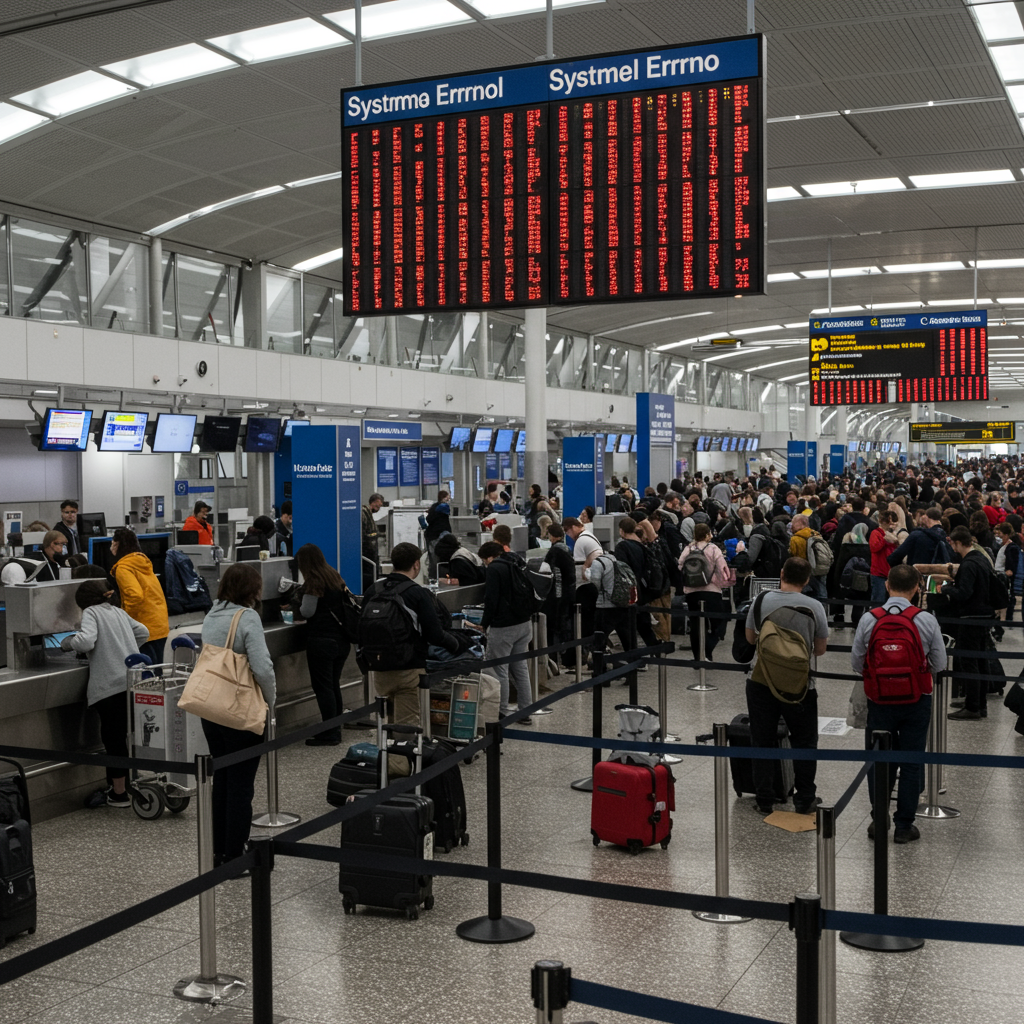A significant cyber-attack targeting a crucial third-party provider plunged several major European airports, including London Heathrow, into widespread disruption. On September 20, 2025, automated check-in and baggage systems failed across the continent, leading to extensive flight delays, cancellations, and a frantic return to manual operations. This incident highlighted the profound vulnerability of modern aviation infrastructure, underscoring how reliance on interconnected digital systems can lead to systemic risks and widespread passenger frustration. Travelers faced hours-long queues and uncertainty, while authorities worked to mitigate the impact of the cyber-related disruption.
The Unfolding Crisis: A Major European Airport Cyber-Attack
The chaos began on Friday night, affecting Brussels Airport, before impacting operations across Europe throughout Saturday, September 20, 2025. The root cause was identified as a “cyber-related disruption” to the Muse software provided by Collins Aerospace, a subsidiary of RTX. This specialized system allows multiple airlines to share check-in desks and boarding gates efficiently, making it a critical component of airport functionality. When Muse went offline, the ripple effect was immediate and severe.
London Heathrow, Europe’s busiest airport, was prominently affected. Other key locations experiencing significant issues included Brussels Airport, Berlin Brandenburg Airport, Dublin Airport, and Cork Airport. While British Airways managed to maintain normal operations by utilizing a backup system, many other airlines operating from Heathrow faced substantial delays and technical hurdles. Collins Aerospace acknowledged the incident, confirming that the disruption was limited to electronic customer check-in and baggage drop, and could be managed through manual processes.
Chaos on the Ground: Passenger Stories and Operational Strain
The direct impact on passengers was immediate and distressing. Travelers at affected airports reported multi-hour delays, long queues, and a distinct lack of clear communication. At Heathrow’s Terminal 4, Lucy Spencer described a two-hour wait for a Malaysia Airlines flight, only for mobile boarding passes to fail at the gates, forcing passengers back to check-in. Staff were observed manually tagging luggage and processing check-ins over the phone, a stark contrast to the usual automated efficiency.
Further exacerbating the stress, Monazza Aslam found herself stuck on the tarmac for over an hour, missing an onward connection at Doha. Johnny Lal, on his way to a funeral in Bombay with his elderly mother, faced the additional challenge of being unable to secure a mobility scooter due to the system outages. His mother, unable to walk without assistance, was stranded, illustrating the profound human cost of such technical failures. While Terminal 3 at Heathrow reportedly saw faster-moving queues with specific flights being called out, the overall scene across affected terminals was one of significant disruption. Brussels Airport declared a “large impact on the flight schedule,” prompting Europe’s aviation safety organization, Eurocontrol, to request that airlines cancel half their flights to and from Brussels between Saturday and Monday morning.
Understanding the Target: Collins Aerospace and System Vulnerabilities
The cyber-attack underscored the inherent fragility of modern air travel’s digital backbone. Collins Aerospace, a U.S.-based technology provider, supplies critical self-service kiosks and back-end systems globally. Their Muse software, designed for efficiency, inadvertently created a “single point of failure,” as noted by computer science lecturer Hisham Al Assam. A compromise in one centralized system could disrupt numerous airlines simultaneously across various airports.
This incident is not isolated. The aviation industry has witnessed a concerning trend of increasing cyber threats, with a staggering 600% rise in aviation cyber-attacks specifically between 2024 and 2025. This current attack draws parallels to a global IT crash in July 2023, caused by a faulty software update, which grounded flights across the US. Such events highlight the sector’s acute vulnerability to digital system failures and the critical need for robust cybersecurity measures and resilient backup infrastructure.
Official Response and Investigation Efforts
Authorities across Europe moved swiftly to address the unfolding crisis. The UK’s National Cyber Security Centre (NCSC) confirmed it was “working with” Collins Aerospace, affected UK airports, the Department for Transport, and law enforcement to fully comprehend the incident’s impact. Transport Secretary Heidi Alexander confirmed receiving regular updates, monitoring the situation closely.
The European Commission stated it was “closely monitoring the cyber attack” but reassured the public that there was no indication of a “widespread or severe attack” and, crucially, that aviation safety and air traffic control systems remained unaffected. They collaborated with EUROCONTROL, ENISA, airports, and airlines to restore operations and support passengers. Germany’s federal office for information security (BSI) also engaged with Berlin Airport regarding the infrastructure disruptions. Despite these efforts, the origin and specific nature of the attack remained under investigation, with no group or individual publicly claiming responsibility.
Who is Behind the Attack? Speculation vs. Reality
Initial speculation, including unfounded accusations of Kremlin-sponsored hackers, circulated in the wake of the attack. However, cybersecurity experts largely pointed to criminal gangs as the most likely perpetrators. Major cyber-attacks in recent years have predominantly been carried out by groups focused on financial gain through ransomware or extortion, generating hundreds of millions of dollars annually by stealing data or holding systems hostage for bitcoin payments.
While many hacking gangs are headquartered in Russia or former Soviet countries, some with alleged ties to the Russian state, there have also been notable arrests elsewhere, with British and American teenagers accused of carrying out other large cyber-attacks. At the time of reporting, it was explicitly stated that it was far too early to definitively know the identity or motive behind this specific attack. Some cybersecurity experts did suggest it could be a ransomware attack, a tactic also occasionally employed by state-sponsored actors. Collins Aerospace had not publicly commented on the nature or origin of the hack, nor on past allegations of being targeted by ransom-seeking hackers in 2023. Liberal Democrats MP Calum Miller called for a government statement on potential Kremlin involvement, linking it to recent Russian military activities.
Navigating Disruption: Advice for Travelers and Industry Implications
Actionable Advice for Travelers
In the face of such widespread technical disruptions, travelers must remain vigilant and proactive. Airports and airlines consistently advise passengers to:
Check Flight Status: Always verify your flight’s status directly with your airline before traveling to the airport. This is the most crucial step to avoid unnecessary journeys.
Arrive Early: If your flight is confirmed, arrive with ample time – typically three hours before a long-haul flight and two hours for a domestic flight – to account for potential manual processes and longer queues.
Stay Informed: Monitor official communications from your airline and airport. Be prepared for last-minute changes, including delays or cancellations.
Understand Your Rights: Travel journalist Simon Calder highlighted the relevance of passenger rights regarding compensation or alternative arrangements for delayed or canceled flights. Familiarize yourself with these rights.
Long-Term Cybersecurity Challenges
The September 2025 cyber-attack serves as a stark reminder of the critical reliance of global transportation on complex, interconnected digital systems. The incident underscores several key implications for the aviation industry:
Systemic Risk: Dependence on third-party software providers creates systemic vulnerabilities. A single point of failure can trigger cascading disruptions across multiple countries and airlines.
Enhanced Cybersecurity: There is an urgent need for continuous investment in advanced cybersecurity measures, including robust threat detection, prevention, and response capabilities.
Resilience and Redundancy: Developing resilient digital infrastructure with strong backup systems and comprehensive recovery plans is paramount to mitigate the impact of future attacks.
Information Sharing: Improved collaboration and information sharing between governments, cybersecurity agencies, airports, and airlines are essential to counter evolving cyber threats effectively.
Frequently Asked Questions
What caused the widespread flight delays at European airports recently?
The significant flight delays and disruptions at several major European airports on September 20, 2025, were caused by a cyber-attack targeting the Muse software. This critical electronic check-in and baggage system is provided by Collins Aerospace, a subsidiary of RTX. The attack impacted the automated systems, forcing airports to revert to slower, manual check-in and baggage drop processes, leading to extensive operational challenges.
Which major European airports were primarily affected by the recent cyber-attack?
The primary airports significantly affected by the cyber-attack on Collins Aerospace’s systems included London Heathrow, Brussels Airport, and Berlin Brandenburg Airport. Additionally, Dublin Airport and Cork Airport experienced minor impacts, requiring some airlines to implement manual check-in procedures. While these airports bore the brunt, some major hubs like Frankfurt and Paris-area airports reported no related disruptions.
What should travelers do if their flight is affected by a cyber-attack or technical disruption?
If your flight is affected by a cyber-attack or similar technical disruption, it is crucial to first check your flight’s status directly with your airline before heading to the airport. Travelers should also plan to arrive significantly earlier than usual – typically three hours for long-haul and two for domestic flights – to account for potential manual processes and longer queues. Staying informed through official airline and airport communications and understanding your passenger rights regarding delays and cancellations are also vital steps.
Conclusion
The cyber-attack that rattled European airports on September 20, 2025, stands as a critical incident, highlighting the pervasive and evolving nature of digital threats facing vital global infrastructure. While the immediate focus was on resolving delays and assisting frustrated passengers, the broader implications for aviation cybersecurity are profound. This event serves as a powerful reminder that in an increasingly interconnected world, the resilience of our digital systems is paramount. Continuous investment in robust cybersecurity defenses, vigilant monitoring, and collaborative efforts across the industry are not just advisable, but essential to safeguard the integrity of air travel and ensure passenger confidence in the digital age.




